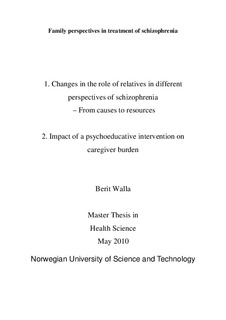| dc.contributor.author | Walla, Berit | nb_NO |
| dc.date.accessioned | 2014-12-19T14:33:39Z | |
| dc.date.available | 2014-12-19T14:33:39Z | |
| dc.date.created | 2011-03-18 | nb_NO |
| dc.date.issued | 2010 | nb_NO |
| dc.identifier | 404868 | nb_NO |
| dc.identifier.uri | http://hdl.handle.net/11250/267730 | |
| dc.description.abstract | 1. Changes in the role of relatives in different perspectives of schizophrenia – From causes to resources
Purpose: The current paper aims to describe the last century changes in the relatives’ role in treatment of individuals with schizophrenia in medical, psychological, social, and research perspective.
Methods: A literature review was obtained by searches on Bibsys, Helsebiblioteket, ISI web of Science, and PubMed. Key words were schizophrenia, psychosis, psychiatric history, caregiver burden, family intervention. Evidence based literature was obtained via searches of ISI Web of Science, EBCON, Pubmed, and Google Scholar computerized databases from 1960 through November 2008. Reports of earlier reviews of literature and original research were included.
Conclusions: From being assumed as a cause of mental illness, to influence course and relapse, and now to be an important resource of the treatment and recovery of the patient, the relatives now are also recognized as caregivers with their own needs for help and support. There are still challenges to include evidence-based treatment in the clinical settings. | nb_NO |
| dc.description.abstract | 2. Impact of a psychoeducative intervention on caregiver burden
Objective: intervention on negative appraisal of caregiving experience, positive appraisal of caregiving experience, and health and functioning in relatives of patients with psychotic disorders compared to a waiting list control.
Methods: Family members (N=68) of patients with psychosis received a six-session (a total of 15 hours), multi-family format psychoeducative intervention, - and completed an Experience of Caregiving Inventory (ECI) and COOP/WONCA (CW), which is a self reporting measure of the general state of health and functioning at the beginning, and at the end of the intervention. Those who went directly to the intervention (N=36) was used as intervention group and those who had to be on a waiting list (N=32) was used as a control group.
Results: The study revealed significant differences between the psychoeducative intervention group on the ECI subcategory “problems with services” after the intervention period compared to the change in the control group (reduction mean -0.10v. 2.36; P= 0.043, effect size 0.062). There were no significant differences at the ECI total negative, the ECI positive subcategories, or on the C/W.
Conclusion: The findings in this study suggest that psychoeducational intervention have reduced the relatives’ negative appraisal of the mental health services, but not increased the positive appraisals of experiences or the health and functional level. | nb_NO |
| dc.language | eng | nb_NO |
| dc.publisher | Norges teknisk-naturvitenskapelige universitet, Fakultet for samfunnsvitenskap og teknologiledelse, Institutt for sosialt arbeid og helsevitenskap | nb_NO |
| dc.title | Family perspectives in treatment of schizophrenia | nb_NO |
| dc.type | Master thesis | nb_NO |
| dc.contributor.department | Norges teknisk-naturvitenskapelige universitet, Fakultet for samfunnsvitenskap og teknologiledelse, Institutt for sosialt arbeid og helsevitenskap | nb_NO |

